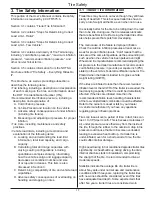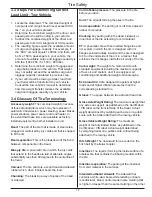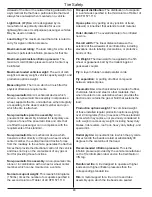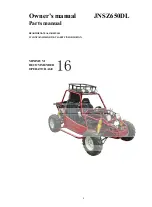
11
^
WARNING
Do not transport fl ammable, explosive,
poisonous or other dangerous materials
on your trailer.
The exception is fuel in the tank of a
vehicle or equipment being hauled.
2.2.13 Inoperable Brakes Or Lights
If your trailer has electric brakes, your tow vehicle will
have an electric brake controller that sends power to
the trailer brakes.
Before towing the trailer, you must operate the brake
controller while trying to pull the trailer in order to
confi rm that the electric brakes operate. While towing
the trailer at less than 5 mph, manually operate the
electric brake controller in the tow vehicle cab. You
should feel the operation of the trailer brakes.
If your trailer has hydraulic “surge” brakes, pull the
emergency breakaway brake lanyard to check the
operation of the surge mechanism.
Be sure that the electric brakes and all of the lights
on your trailer are functioning properly before towing
the trailer. Electric brakes and lights on a trailer
are controlled via a connection to the tow vehicle,
generally a multi-pin electrical connector.
^
WARNING
Improper electrical connection between
the tow vehicle and the trailer will result in
inoperable lights and electric brakes, and
can lead to collision.
Before each tow:
• Check that the electric brakes work by
operating the brake controller inside the
tow vehicle.
• Check that all lights and turn signals
work.
You must provide mirrors that allow you to safely
observe approaching traffi c. Standard mirrors usually
do not provide adequate visibility for viewing traffi c to
the sides and rear a towed trailer.
2.2.14 Trailer Modifi cations
Modifi cation of the trailer structure or alteration of
your trailer can make the trailer unsafe and will void
all warranty options. Before making any alteration to
the trailer, contact your dealer or the manufacturer
and describe the alteration you are contemplating.
2.2.15 Trailer Towing Guide
Driving a vehicle with a trailer in tow is vastly different
from driving the same vehicle without a trailer in tow.
Acceleration, maneuverability and braking are all
diminished with a trailer in tow. It takes longer to get
up to speed; you need more room to turn and pass,
and more distance to stop when towing a trailer.
You will need to spend time adjusting to the different
feel and maneuverability of the tow vehicle with a
loaded trailer. Because of the signifi cant differences
in all aspects of maneuverability when towing a trailer,
the hazards and risks of injury are also much greater
than when driving without a trailer.
You are responsible for keeping your vehicle and
trailer in control, and for all the damage that is caused
if you lose control of your vehicle and trailer.
Find an open area with little or no traffi c for your fi rst
practice. Before you start towing the trailer, you must
follow all of the instructions for inspection, testing,
loading and coupling. Also, before you start towing,
adjust the mirrors so you can see the trailer as well as
the area to the rear of it.
Drive slowly at fi rst, 5 mph or so, and turn the wheel
to get the feel of how the tow vehicle and trailer
combination responds. Next, make some right and left
hand turns. Watch in your side mirrors to see how the
trailer follows the tow vehicle. Turning with a trailer
attached requires more room.
Stop the rig a few times from speeds no greater than
10 mph. If your trailer is equipped with brakes, try
using different combinations of trailer/electric brake
and tow vehicle brake. Note the effect that the trailer
brakes have when they are the only brakes used.
When properly adjusted, the trailer brakes will come
on just before the tow vehicle brakes.
It will take practice to learn how to back up a tow
vehicle with a trailer attached. Take it slow. Before
backing up, get out of the tow vehicle and look behind
the trailer to make sure that there are no obstacles.
Safety
Summary of Contents for Utility Trailer
Page 14: ...14 Safety ...
Page 52: ...52 ...












































